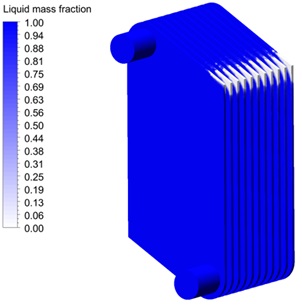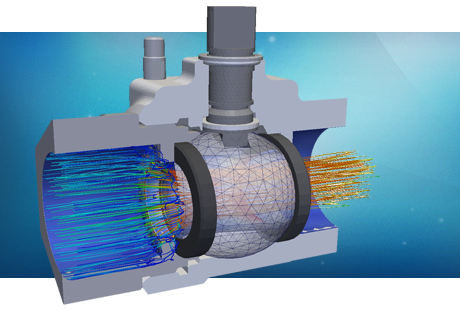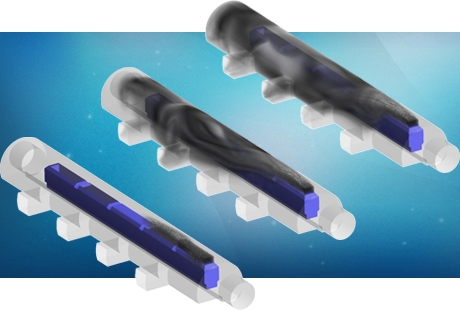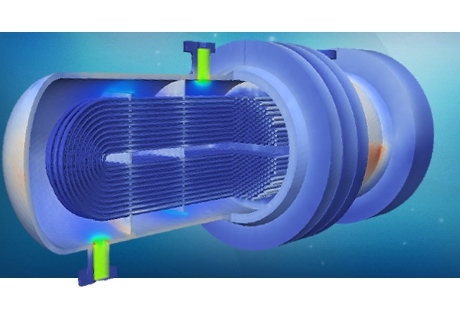Heat exchange products
Heat exchangers are critical elements of energy managements systems and are often where the most straight-forward and effective optimisation can take place. Most industrial systems use one form or another of heat exchangers, including oil & gas, energy generation and most chemical processes.
Heat exchangers aim to transfer heat between the flows of working fluid either directly, which involves mixing, or indirectly, which involves separation of the fluids via pipes or panels.
 Depending on geometric constraints and applications, the flow of hot and cold fluids can be parallel (co-flow), perpendicular (cross flow) or counter flow. The latter being most efficient for most applications in light of the greater average temperature difference. The flows can present a single or multiple passes of working fluids, offering a balance between pressure loss and efficiency of the heat transfer. This quickly results in fairly complex thermodynamic interdependency of the flows which is best captured by the use of numerical methods. PRE Technologies have developed a range of tools, of varying complexity, to provide cost-effective simulation of classical heat exchangers as well as more complex local effects or mechanical behaviour.
Depending on geometric constraints and applications, the flow of hot and cold fluids can be parallel (co-flow), perpendicular (cross flow) or counter flow. The latter being most efficient for most applications in light of the greater average temperature difference. The flows can present a single or multiple passes of working fluids, offering a balance between pressure loss and efficiency of the heat transfer. This quickly results in fairly complex thermodynamic interdependency of the flows which is best captured by the use of numerical methods. PRE Technologies have developed a range of tools, of varying complexity, to provide cost-effective simulation of classical heat exchangers as well as more complex local effects or mechanical behaviour.
The two most common types of industrial heat exchanger types are plate heat exchangers and shell and tube heat exchangers.
Shell and tube heat exchangers
Shell and tube heat exchangers maximise the surface area of one fluid (typically the cold flow) by running it through a large number of tubes. The shell is a vessel containing the second fluid which surrounds the tubes which have high thermal conductivity. Heat is exchanged through the tube walls. This type of heat exchanger can be subjected to phase change when operating as a boiler or condenser (e.g. surface condenser).
 The distribution of flow through the tubes is governed by plenums and an efficient design is required to avoid excessive pressure drops, particularly in multiple pass straight-tube arrangements. Baffles are often included to optimise the shell side flow path as well as sustain the tubes and prevent vibrations. Tubes can be corrugated to enhance the thermal transfer through the turbulent boundary layer.
The distribution of flow through the tubes is governed by plenums and an efficient design is required to avoid excessive pressure drops, particularly in multiple pass straight-tube arrangements. Baffles are often included to optimise the shell side flow path as well as sustain the tubes and prevent vibrations. Tubes can be corrugated to enhance the thermal transfer through the turbulent boundary layer.
In addition to thermal performance, some common concerns regarding the design of this type of heat exchanger are the mechanical response to the thermal gradients and the potential risk of fatigue. Tubesheets are often subjected to displacements and loading which can be significant. Furthermore, the thermal expansion of the shell itself is to be considered to ensure fatigue does not shorten the life of the product. Special consideration is often required for perforated plates and FEA can provide a cost effective solution to the mechanical analysis of these structures. Pleas visit the boiler thermal fatigue page for more information.

Shell and tube heat exchangers are also pressure vessels and are often operated at high pressure. Thus, they require careful design and compliance with international standards such as ASME BPVC Section VIII or EN 13445-3. PRE Technologies have extensive experience in the thermal, CFD and FEA modelling of heat exchangers to optimise the design’s thermal performance and to ensure structural integrity due to pressures and thermal stresses. Vibration or buckling problems have also been examined. Furthermore, the modelling of multiphase flow and phase change phenomena is also within our capabilities. The modelling of fouling and scaling can also be undertaken with customised CFD tools.

Plate heat exchangers
Plate-and-frame and plate-and-fin heat exchangers are typically used in HVAC, refrigeration, cooling or for chemical production. Patterns of chevrons or grooves are often stamped on the plates to promote heat transfer. Much more intricate manifold design leads to very effective heat transfer between fluids. However, such intricacy can lead to complex flow patterns and analytical methods become less accurate than CFD for the determination of pressure and velocity contours.

Phase change on the energy carrying fluids can also be modelled using computational models in combination with accurate definition of the physical properties of the working fluids. A correct design of the internals of the plate heat exchanger, to avoid stagnant flows, together with an accurate analysis of the start-up and shut-down transient effects on the system can help designers and operators avoid undesired solid blockages.
An example of PRE Technologies experience at modelling plate heat exchangers can be found here.
Other forms of heat exchange
Some less common heat exchangers include spiral heat exchangers or pillow heat exchangers. All aim to maximise the surface area across which heat is transferred and can be very process specific. For example, some heat exchangers have more uniform temperature distributions, which is required in the pasteurisation and heat treatment of foods.

Waste heat recovery is a sector with heat exchanger systems at its heart. Heat recovery steam generators (HSRG) are used in cogeneration to produce steam from hot gas flows in gasifiers. Recuperators or economisers are often designed to optimise energy generation or heating processes by running exhaust flues over inlet tubes. The process can also take intermediate flows and recirculate them via run-around coils. Regenerators recirculate outlet streams to the inlet to preserve energy. Ljungström type rotary preheaters (thermal wheels) are a wide spread example of how outgoing heat is stored in stack material in honeycomb structures through which inlet streams are passed. Heat pumps are also often used to recover low grade heat.
PRE technologies possess the capabilities to analyse both the thermal efficiency, fluid flows and the structural response of heat exchangers in a variety of conformations with the expert use of computational fluid dynamics and finite element analysis tools.
Services portfolio
PRE Technologies offer a wide variety of thermal analyses and has historically collaborated with companies in the following sectors:
Energy (Solar, Nuclear, Biofuels and renewables)
Heat pumps and heat exchangers
Cryogenics
Analyses:
Code compliance (ASME, API, EN 13445-3, PD 5500)
Fluid structure interaction (FSI)
For more information on other services for heat exchange systems, please go to the stress and fatigue in heat exchangers tab or contact us.
Our services for this sector
Shell and tube heat exchangers
- CFD optimisation: Fluid flow and thermal performance
- Code compliance (ASME, API, PD and EN): Stress and fatigue analysis
- Phase change modelling: Condensers and boilers
- Plenum and baffles configuration optimisation: Fluid dynamics assessment
- Thermal shocking modelling: Transient CFD analysis
- Thermal expansion for tubes and tubesheets: FEA stress calculation
Plate heat exchangers
- Plate-and-frame and plate-and-fin fluid flow modelling
- Plates pattern optimisation: Chevrons and grooves
- Code compliance (ASME, API, PD and EN): Stress and fatigue analysis
- Manifold design assessment
Other heat exchange equipment
- Heat recovery steam generator (HRSG) thermal analysis
- Recuperators and economisers thermal assessment
- Underhood thermal management studies
- Lighting and electrical equipment heat sink modelling







